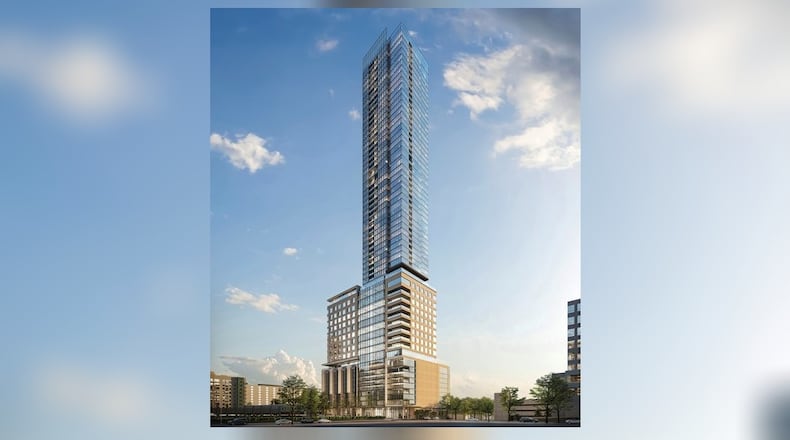A developer broke ground Wednesday on a 60-story tower that’s destined to join the ranks of Atlanta’s tallest skyscrapers, adding a new landmark to the city’s skyline.
New York developer Rockefeller Group held a groundbreaking ceremony to begin vertical construction on the tallest building erected in Atlanta in 30 years at 1072 West Peachtree St. The mixed-use tower will feature 350 market-rate apartments, 224,000 square feet of office space and about 6,300 square feet of ground-floor retail space. At 730 feet, the project would be Atlanta’s fifth-tallest tower when completed.
The Rockefeller Group project begins as the Atlanta office market faces its highest vacancy and availability rate in modern history and as many banks have pumped the brakes on real estate lending. Though it might take years for metro Atlanta’s office market to find its footing, the developer expressed confidence in the project and said the company has secured construction financing.
Rockefeller Group purchased the 1-acre property for $25 million in 2020, mere months after the COVID-19 pandemic disrupted the economy. John Petricola, senior managing director of the southeast region at Rockefeller Group, said Midtown has maintained its status as the epicenter of the city’s business community and luxury living, which helps justify this new tower.
“Even through the pandemic, we felt continually that there was not a lull in demand for Midtown living,” he told The Atlanta Journal-Constitution. “The pandemic actually kind of reinforced our view that this would be a viable location for a monumental investment and project.”
The project site at the corner of West Peachtree and 12th street was formerly a post office building, which Rockefeller Group demolished earlier this year. The building, expected to be the city’s tallest mixed-use building, is Rockefeller Group’s second project in Atlanta. The company previously partnered with Atlanta-based Selig Enterprises on a 64-unit luxury condo tower at 40 West 12th St.
The new tower is being built at a tumultuous time for commercial real estate, especially the office market. Nearly 30% of all office square footage in metro Atlanta was available for rent at the end of June, according to data from real estate services firm CBRE.
The lack of demand coupled with high interest rates and a wave of office debt set to mature in the coming years has spurred a new wave of financial distress and foreclosures in large cities.
Nearly a third of all Midtown office space is either vacant or available for sublease, but the district continues to demand some of the more expensive rents in the city. At the end of June, the average asking lease rate was $38.48 per square foot for office space, according to CBRE. That figure was $37.15 for Buckhead and $30.09 for downtown.
Credit: Rockefeller Group
Credit: Rockefeller Group
Petricola declined to disclose the expected cost of the 1072 West Peachtree project or the details about its construction loan from Sumitomo Mitsui Trust Bank and Taisei USA. Mitsubishi Estate New York is also on the development team, contributing an undisclosed amount of equity.
“Even despite the current market, with the right product and the right development team, you can still achieve and fulfill your capital stack to get the financing needed for your project,” Petricola said.
The building’s office space is concentrated between floors 11 and 19, which Petricola said can be leased among multiple tenants. Rockefeller Group has not announced any tenant signings for the building, which is expected to open in the fourth quarter of 2025.
The top 39 floors will consist of apartments, which will range from studios to three-bedroom units alongside penthouse suites. The building’s upper floors have smaller floor plates, which allow for fewer units on each story. Petricola said that will provide more privacy than most Midtown residential towers. Some of the residential units will also line floors 2 through 9, which will also house a 730-space parking deck.
The project will also feature Midtown’s largest outdoor amenity deck, which Petricola said reflecting increased demand for open-air spaces.
“The pandemic did influence how we designed the building,” he said.
About the Author
Keep Reading
The Latest
Featured




